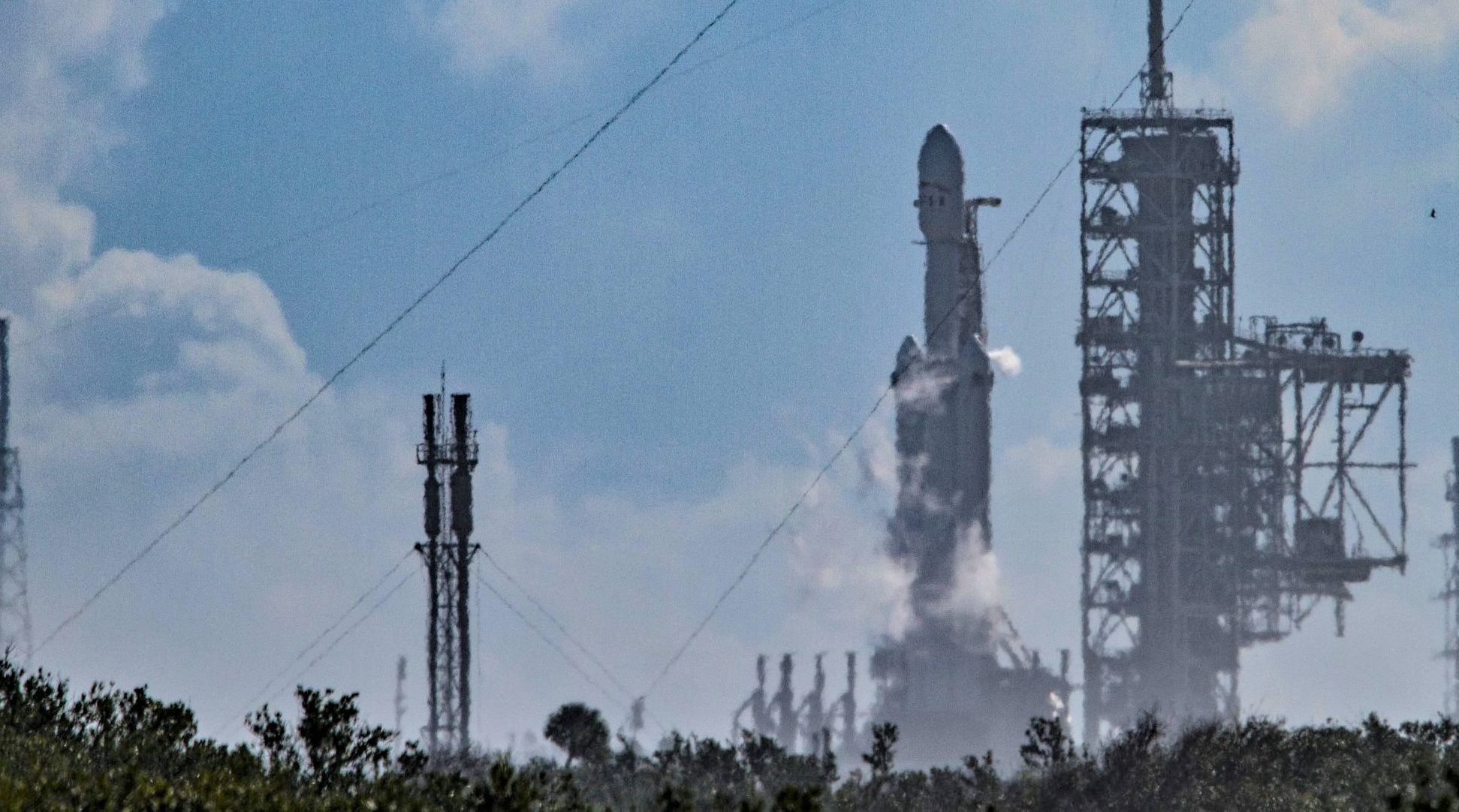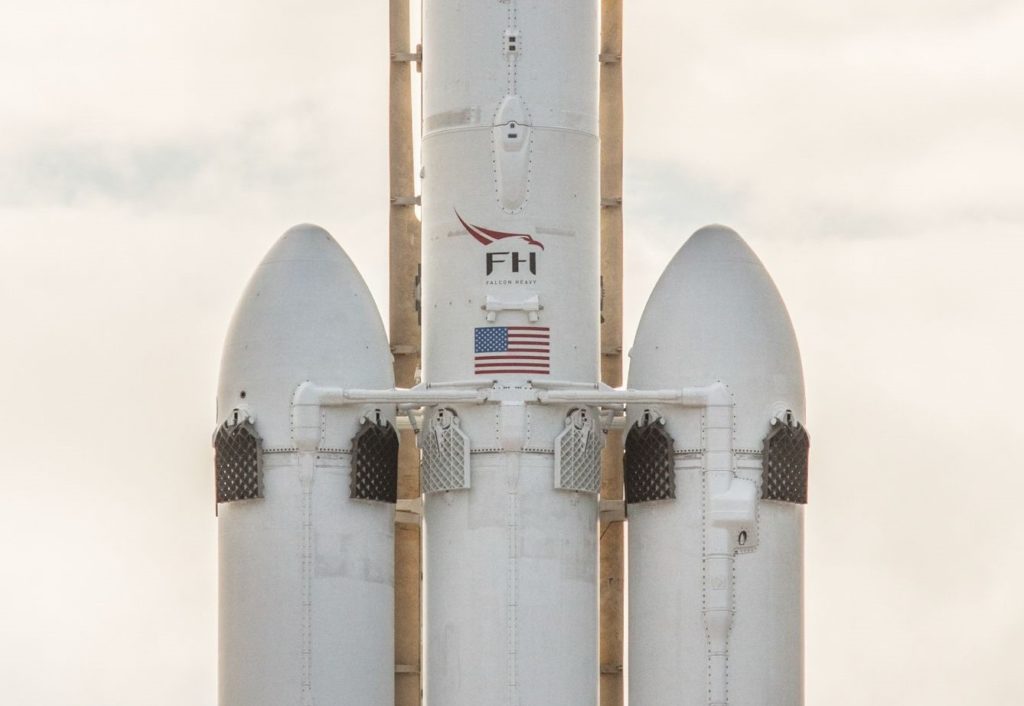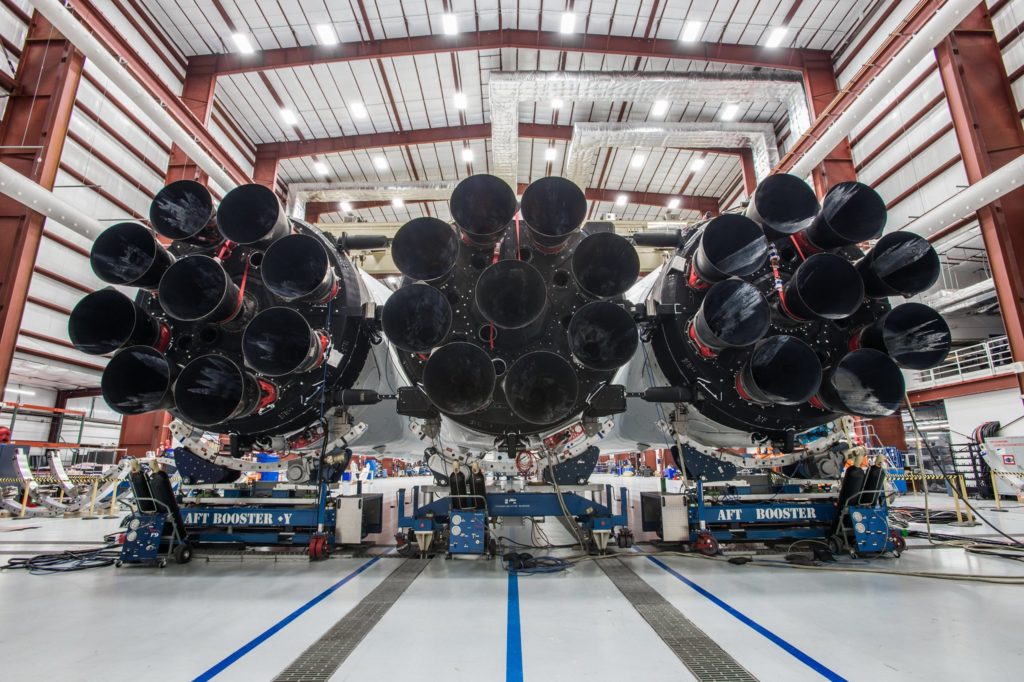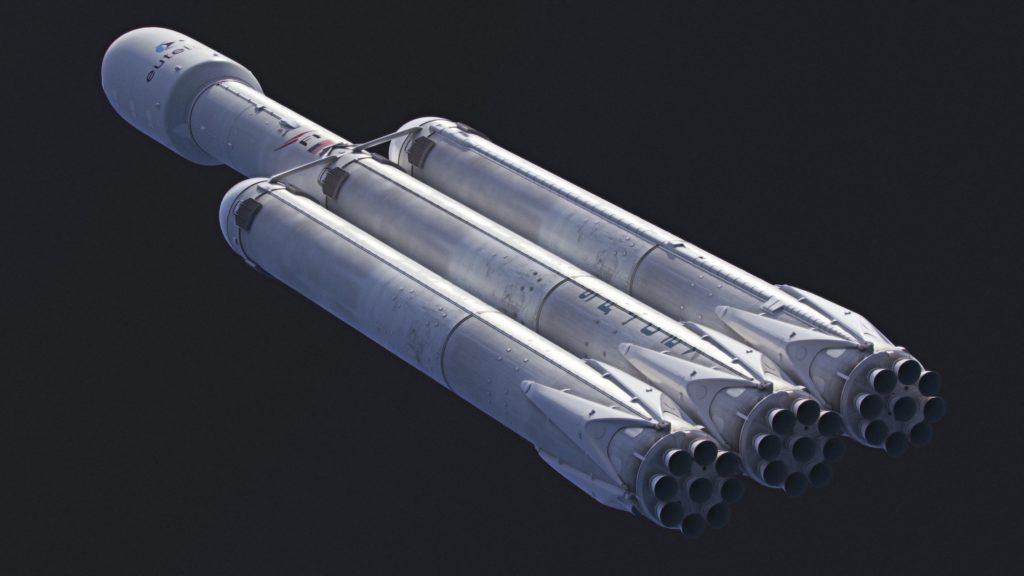

News
What’s causing SpaceX’s Falcon Heavy delays?
Although uncertainty in the schedule remains, SpaceX’s Falcon Heavy rocket appears to be nearly ready for its first engine ignition test (called a ‘static fire’) sometime within the next week or so.
An attempt at 1 PM EST today, January 16, was canceled for unspecified reasons, although Kennedy Space Center reportedly maintained the usual roadblock to prevent vehicles from driving past, implying that SpaceX still intends to conduct propellant loading tests with Falcon Heavy. It was noted earlier this morning by spaceflight journalist Chris Bergin that things were “a bit too quiet” if a test was indeed planned for today, and his intuition appears to have been correct. It still remains the case that Falcon Heavy is an experimental and untested rocket to an extent, and these delays are to be expected as SpaceX works out the inevitable kinks and bugs that arise during the extensive testing big launch vehicle has been and is still being put through.
KSC is in roadblock stance, so they will still do some testing it would seem, but we will have to wait for the Static Fire itself. https://t.co/DxzsRn85NR
— NSF – NASASpaceflight.com (@NASASpaceflight) January 16, 2018
Due to range requirements in support of an upcoming launch of the United Launch Alliance’s (ULA) Atlas 5 rocket, currently NET Thursday, SpaceX has postponed the static fire of Falcon Heavy without a replacement date. It is unlikely that another attempt will occur before the upcoming weekend, but SpaceX should have at least a solid week of uninterrupted range support once ULA’s launch occurs, hopefully without delay. Godspeed to ULA, in the meantime.
The crazy complexity of rocketry
Most recently, and perhaps somewhat related to Falcon Heavy’s static fire delays, SpaceX completed as many as two complete wet dress rehearsals (WDRs), which saw Falcon Heavy topped off with full tanks of its cryogenic (super cool) liquid oxygen (LOX) and rocket-grade jet fuel (RP-1). In essence, the rocket became equivalent to several hundred tons of carefully stabilized explosive. Nominally, these rehearsals appear entirely uneventful to an outside observer, with little more than ice formation and the occasional bursts of propellant tank vents to suggest that something important is occurring. However, anomalies like the failure of Falcon 9 during the Amos-6 static fire provide a staggering demonstration of just how explosive and sensitive a rocket’s fuel is, and Falcon Heavy has approximately three times the fuel capacity of Falcon 9. Empty, Falcon 9’s mass has been estimated to be around 30 metric tons, a minuscule amount of structure in the face of the more than 500 metric tons of propellant the vehicle carries at liftoff.
These propellant loading tests can also be challenging for reasons aside from their highly explosive nature. Due to basic realities of the physical nature of metal, the predominate ingredient for Falcon 9’s load-bearing structures, metallic structures shrink under extreme cold (and expand under heating). In the case of Falcon 9’s massive 45 meters (150 foot) tall first stage, the scale of this contraction can be on the order of several inches or more, particularly given SpaceX’s predilection towards cooling their propellant as much as possible to increase its energy density. For Falcon 9, these issues (thermodynamic loads) are less severe. However, add in three relatively different first stage boosters linked together with several extremely strong supports at both their tops and bottoms and that dynamic loading can become a fickle beast. The expansion or compression of materials due to temperature changes can create absolutely astounding amounts of pressure – if you’ve ever forgotten a glass bottled drink in the freezer and discovered it violently exploded at some future point, you’ll have experienced this yourself.
With several inches of freedom and the possibility that each Falcon Heavy booster might contract or expand slightly differently, these forces could understandably wreak havoc with the high precision necessary for the huge rocket to properly connect with the launch pad’s ground systems that transmit propellant, fluids, and telemetry back and forth. Information from two reliable Kennedy Space Center sources experienced with the reality of operating rockets, as well as NASASpaceflight.com, suggested that issues with dynamic loads (such as those created by thermal contraction/expansion) are a likely explanation for the delays, further evidenced by their observations that much of the pad crew’s attention appeared to be focused at the base of Transporter/Erector/Launcher (TEL). The TEL base hosts the clamps that hold the rocket down during static fires and launches, as well as the Tail Service Masts (TSMs) that connect with the Falcon 9/Heavy to transport propellant and data to the first stage(s). These connection points are both relatively tiny, mechanically sensitive, and absolutely critical for the successful operation of the rocket, and thus are a logical point of failure in the event of off-nominal or unpredicted levels of dynamic stresses.
- The white bars in this photo are half of Falcon Heavy’s seperation mechanism. A number of actuators take the place of the more common solid rocket motors used with vehicles like the Delta IV Heavy. (SpaceX)
- Falcon Heavy’s three boosters and 27 Merlin 1D engines on full display. (SpaceX)
- Falcon Heavy. Modeled and rendered by NASASpaceflight forum user WBY1984. (WBY1984)
Test, launch, land, repeat.
All things considered, these difficulties demonstrate that even after months (even years) of relentless modeling, testing, remodeling, and retesting, rockets (and especially huge rockets like Falcon Heavy) are immensely complex, and even tiny mistakes can lead the vehicle to stray from its expected behavior. Quite simply, the reality of engineering only truly comes into play once hardware is fully in the loop, and it’s in this state that SpaceX has demonstrated again and again a distinct and elegant ability to learn from their hardware, rather than attempt to salve uncertainty with a neurotic and counterproductive level of statistical analysis, modelling, and documentation. The agile launch company still dabbles in those aspects when beneficial or necessary, but testing comes first in its importance.
The conclusion here, then, is that Falcon Heavy’s delays betray this aspect of SpaceX – a launch company that loves its fans, but also understands the need for cautious testing when it comes to new and untried rocket hardware. Whether Falcon Heavy succeeds or fails, SpaceX will learn from the proceedings, and they will be better off for it (although maybe less so financially…).
Follow along live as launch photographer Tom Cross and I cover these exciting proceedings as close to live as possible.
Teslarati – Instagram – Twitter
Tom Cross – Instagram
Eric Ralph – Twitter
Elon Musk
Tesla investors will be shocked by Jim Cramer’s latest assessment
Jim Cramer is now speaking positively about Tesla, especially in terms of its Robotaxi performance and its perception as a company.

Tesla investors will be shocked by analyst Jim Cramer’s latest assessment of the company.
When it comes to Tesla analysts, many of them are consistent. The bulls usually stay the bulls, and the bears usually stay the bears. The notable analysts on each side are Dan Ives and Adam Jonas for the bulls, and Gordon Johnson for the bears.
Jim Cramer is one analyst who does not necessarily fit this mold. Cramer, who hosts CNBC’s Mad Money, has switched his opinion on Tesla stock (NASDAQ: TSLA) many times.
He has been bullish, like he was when he said the stock was a “sleeping giant” two years ago, and he has been bearish, like he was when he said there was “nothing magnificent” about the company just a few months ago.
Now, he is back to being a bull.
Cramer’s comments were related to two key points: how NVIDIA CEO Jensen Huang describes Tesla after working closely with the Company through their transactions, and how it is not a car company, as well as the recent launch of the Robotaxi fleet.
Jensen Huang’s Tesla Narrative
Cramer says that the narrative on quarterly and annual deliveries is overblown, and those who continue to worry about Tesla’s performance on that metric are misled.
“It’s not a car company,” he said.
He went on to say that people like Huang speak highly of Tesla, and that should be enough to deter any true skepticism:
“I believe what Musk says cause Musk is working with Jensen and Jensen’s telling me what’s happening on the other side is pretty amazing.”
Tesla self-driving development gets huge compliment from NVIDIA CEO
Robotaxi Launch
Many media outlets are being extremely negative regarding the early rollout of Tesla’s Robotaxi platform in Austin, Texas.
There have been a handful of small issues, but nothing significant. Cramer says that humans make mistakes in vehicles too, yet, when Tesla’s test phase of the Robotaxi does it, it’s front page news and needs to be magnified.
He said:
“Look, I mean, drivers make mistakes all the time. Why should we hold Tesla to a standard where there can be no mistakes?”
It’s refreshing to hear Cramer speak logically about the Robotaxi fleet, as Tesla has taken every measure to ensure there are no mishaps. There are safety monitors in the passenger seat, and the area of travel is limited, confined to a small number of people.
Tesla is still improving and hopes to remove teleoperators and safety monitors slowly, as CEO Elon Musk said more freedom could be granted within one or two months.
News
Tesla launches ultra-fast V4 Superchargers in China for the first time
Tesla has V4 Superchargers rolling out in China for the first time.

Tesla already has nearly 12,000 Supercharger piles across mainland China. However, the company just initiated the rollout of the ultra-fast V4 Superchargers in China for the first time, bringing its quick-charging piles to the country for the first time since their launch last year.
The first batch of V4 Superchargers is now officially up and running in China, the company announced in a post on Chinese social media outlet Weibo today.
The company said in the post:
“The first batch of Tesla V4 Superchargers are online. Covering more service areas, high-speed charging is more convenient, and six-layer powerful protection such as rain and waterproof makes charging very safe. Simultaneously open to non-Tesla vehicles, and other brands of vehicles can also be charged. There are more than 70,000 Tesla Superchargers worldwide. The charging network layout covers 100% of the provincial capitals and municipalities in mainland China. More V4 Superchargers will be put into use across the country. Optimize the charging experience and improve energy replenishment efficiency. Tesla will accompany you to the mountains, rivers, lakes, and seas with pure electricity!”
The first V4 Superchargers Tesla installed in China are available in four cities across the country: Shanghai, Zhejiang, Gansu, and Chongqing.

Credit: Tesla China
Tesla has over 70,000 Superchargers worldwide. It is the most expansive and robust EV charging network in the world. It’s the main reason why so many companies have chosen to adopt Tesla’s charging connector in North America and Europe.
In China, some EVs can use Tesla Superchargers as well.
The V4 Supercharger is capable of charging vehicles at speeds of up to 325kW for vehicles in North America. This equates to over 1,000 miles per hour of charging.
Elon Musk
Elon Musk hints at when Tesla could reduce Safety Monitors from Robotaxi
Tesla could be reducing Safety Monitors from Robotaxi within ‘a month or two,’ CEO Elon Musk says.

Elon Musk hinted at when Tesla could begin reducing Safety Monitors from its Robotaxis. Safety Monitors are Tesla employees who sit in the front passenger seat during the driverless rides, and are there to ensure safety for occupants during the earliest rides.
Tesla launched its Robotaxi fleet in Austin last Sunday, and after eight days, videos and reviews from those who have ridden in the driverless vehicles have shown that the suite is safe, accurate, and well coordinated. However, there have been a few hiccups, but nothing that has put anyone’s safety in danger.
A vast majority — close to all of the rides — at least according to those who have ridden in the Robotaxi, have been performed without any real need for human intervention. We reported on what was the first intervention last week, as a Safety Monitor had to step in and stop the vehicle in a strange interaction with a UPS truck.
Watch the first true Tesla Robotaxi intervention by safety monitor
The Tesla and UPS delivery truck were going for the same street parking space, and the Tesla began to turn into it. The UPS driver parallel parked into the spot, which was much smaller than his truck. It seemed to be more of an instance of human error instead of the Robotaxi making the wrong move. This is something that the driverless cars will have to deal with because humans are aggressive and sometimes make moves they should not.
The Safety Monitors have not been too active in the vehicles. After all, we’ve only seen that single instance of an intervention. There was also an issue with the sun, when the Tesla braked abnormally due to the glare, but this was an instance where the car handled the scenario and proceeded normally.
With the Robotaxi fleet operating impressively, some are wondering when Tesla will begin scaling back both the Safety Monitors and Teleoperators that it is using to ensure safety with these early rides.
CEO Elon Musk answered the inquiry by stating, “As soon as we feel it is safe to do so. Probably within a month or two.”
As soon as we feel it is safe to do so.
Probably within a month or two. We continue to improve the Tesla AI with each mile driven.
— Elon Musk (@elonmusk) June 30, 2025
Musk’s response seems to confirm that there will be fewer Teleoperators and Safety Monitors in the coming months, but there will still be some within the fleet to ensure safety. Eventually, that number will get to zero.
Reaching a point where Tesla’s Robotaxi is driverless will be another significant milestone for the company and its path to fully autonomous ride-sharing.
Eventually, Tesla will roll out these capabilities to consumer-owned vehicles, offering them a path to generate revenue as their car operates autonomously and completes rides.
For now, Tesla is focusing on perfecting the area of Austin where it is currently offering driverless rides for just $4.20 to a small group of people.
-

 News5 days ago
News5 days agoTesla Robotaxi’s biggest challenge seems to be this one thing
-

 News2 weeks ago
News2 weeks agoTesla confirms massive hardware change for autonomy improvement
-

 Elon Musk2 weeks ago
Elon Musk2 weeks agoElon Musk slams Bloomberg’s shocking xAI cash burn claims
-

 News2 weeks ago
News2 weeks agoTesla China roars back with highest vehicle registrations this Q2 so far
-

 News2 weeks ago
News2 weeks agoTesla features used to flunk 16-year-old’s driver license test
-

 News2 weeks ago
News2 weeks agoTexas lawmakers urge Tesla to delay Austin robotaxi launch to September
-

 News2 weeks ago
News2 weeks agoTesla dominates Cars.com’s Made in America Index with clean sweep
-

 News2 weeks ago
News2 weeks agoTesla’s Grok integration will be more realistic with this cool feature
























